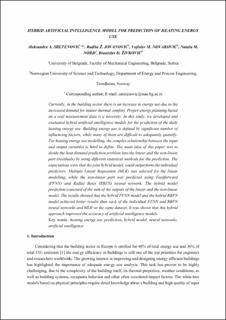| dc.contributor.author | Sretenovic, Aleksandra | |
| dc.contributor.author | Jovanovic, Radisa | |
| dc.contributor.author | Novakovic, Vojislav | |
| dc.contributor.author | Nord, Natasa | |
| dc.contributor.author | Zivkovic, Branislav | |
| dc.date.accessioned | 2021-10-21T11:55:11Z | |
| dc.date.available | 2021-10-21T11:55:11Z | |
| dc.date.created | 2021-05-10T09:35:28Z | |
| dc.date.issued | 2021 | |
| dc.identifier.issn | 0354-9836 | |
| dc.identifier.uri | https://hdl.handle.net/11250/2824502 | |
| dc.description.abstract | Currently, in the building sector there is an increase in energy use due to the increased demand for indoor thermal comfort. Proper energy planning based on a real measurement data is a necessity. In this study, we developed and evaluated hybrid artificial intelligence models for the prediction of the daily heating energy use. Building energy use is defined by significant number of influencing factors, while many of them are difficult to adequately quantify. For heating energy use modelling, the complex relationship between the input and output variables is hard to define. The main idea of this paper was to divide the heat demand prediction problem into the linear and the non-linear part (residuals) by using different statistical methods for the prediction. The expectations were that the joint hybrid model, could outperform the individual predictors. Multiple Linear Regression was selected for the linear modelling, while the non-linear part was predicted using Feedforward and Radial Basis neural networks. The hybrid model prediction consisted of the sum of the outputs of the linear and the non-linear model. The results showed that both hybrid models achieved better results than each of the individual Feedforward and Radial Basis neural networks and Multiple Linear Regression on the same dataset. It was shown that this hybrid approach improved the accuracy of artificial intelligence models. | en_US |
| dc.language.iso | eng | en_US |
| dc.publisher | VINČA Institute of Nuclear Sciences | en_US |
| dc.relation.uri | http://www.doiserbia.nb.rs/Article.aspx?ID=0354-98362100152S#.YJjg-qKyRpU | |
| dc.rights | Attribution-NonCommercial-NoDerivatives 4.0 Internasjonal | * |
| dc.rights.uri | http://creativecommons.org/licenses/by-nc-nd/4.0/deed.no | * |
| dc.title | Hybrid artificial intelligence model for prediction of heating energy use | en_US |
| dc.type | Peer reviewed | en_US |
| dc.type | Journal article | en_US |
| dc.description.version | publishedVersion | en_US |
| dc.source.journal | Thermal Science | en_US |
| dc.identifier.doi | https://doi.org/10.2298/TSCI210303152S | |
| dc.identifier.cristin | 1909071 | |
| dc.relation.project | Norges forskningsråd: 262707 | en_US |
| cristin.ispublished | true | |
| cristin.fulltext | postprint | |
| cristin.qualitycode | 0 | |

